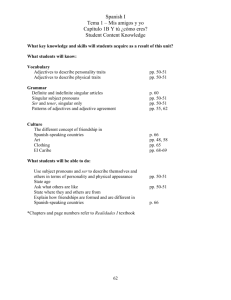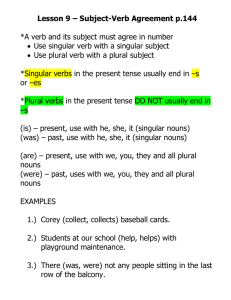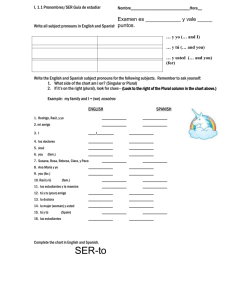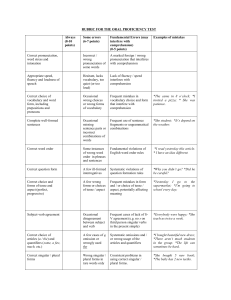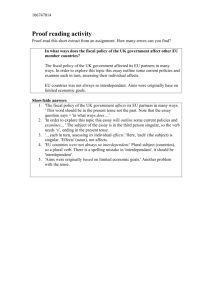Ud.
advertisement
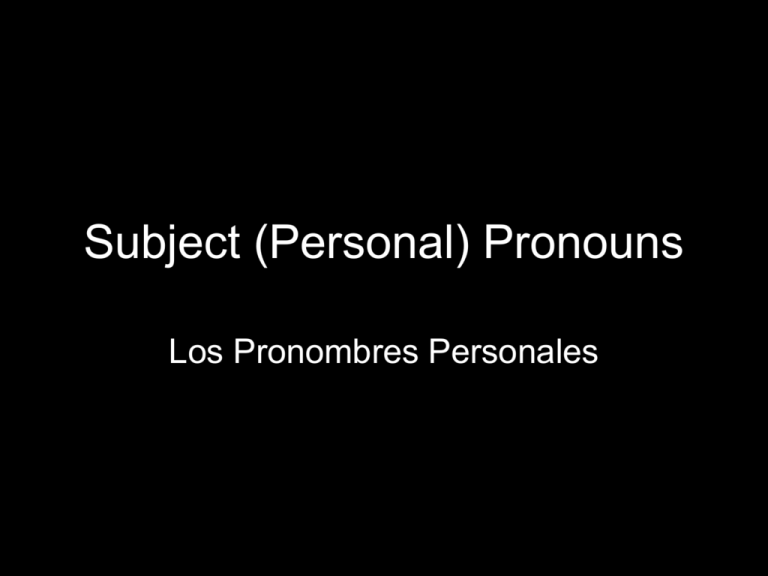
1.3 Present tense of ser Subject (Personal) Pronouns Los Pronombres Personales 1.3 Present tense of ser NTE TODO Subject pronouns In order to use verbs, you will need to learn about subject pronouns. A subject pronoun replaces the name or title of a person or thing and acts as the subject of a verb. In both Spanish and English, subject pronouns are divided into three groups: first person, second person, and third person. 1.3 Present tense of ser Singular FIRST PERSON yo I tú you (familiar) usted (Ud.) you (formal) él he ella she SECOND PERSON THIRD PERSON 1.3 Present tense of ser Subject pronouns Spanish has two subject pronouns that mean you (singular). Use tú when addressing a friend, a family member, or a child you know well. (first name basis) We call this friendly or informal. Use usted to address a person with whom you have a formal or more distant relationship, such as a superior at work, a professor, or an older person. (last name basis, usually with a title) We call this polite or formal. 1.3 Present tense of ser Plural nosotros we (masculine) nosotras we (feminine) vosotros you (masc., fam.) vosotras you (fem., fam) FIRST PERSON SECOND PERSON ustedes (Uds.) you (form.) ellos they (masc.) ellas they (fem.) THIRD PERSON 1.3 Present tense of ser In English, we do not have a plural form of “you.” That is why we hear some people try to create a plural form by saying: “you all,” “yous,” or “ yunzes.” 1.3 Present tense of ser Subject pronouns The masculine plural forms nosotros, vosotros, and ellos refer to a group of males or to a group of males and females. (Very macho) The feminine plural forms nosotras, vosotras, and ellas can refer only to groups made up exclusively of females. 1.3 Present tense of ser In Latin America and throughout a great deal of Spain, there is only one plural form of “you.” (ustedes/Uds.) In a small part of Spain, there are two plural forms of “you.” They use ustedes/Uds. to be polite and Vosotros/Vosotras when being friendly. 1.3 Present tense of ser When expressing “you” plural (You all): Ud. + Ud. = Uds. Ud. + tú = Uds. • Tú+ tú = Vosotros (by some speakers) Tú + Tú = Uds. (by most speakers) 1.3 Present tense of ser OJO: Although usted (Ud.) refers to the second person singular and ustedes (Uds.) refers to the second person plural, they take the same verb conjugations as the third person singular and plural. Yo Nosotros (as) Tú Vosotros (as) Ud., Él, Ella Uds., Ellos, Ellas 1.3 Present tense of ser There is no Spanish equivalent of the English subject pronoun it. Generally it is not expressed in Spanish. Instead, the third person singular form of a verb is used. Es un problema. Es una computadora. It’s a problem. = Is a problem. It’s a computer. = Is a computer..


